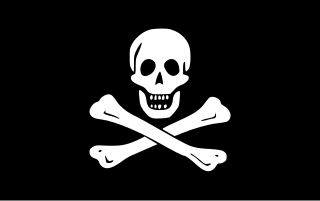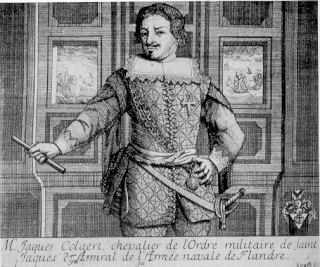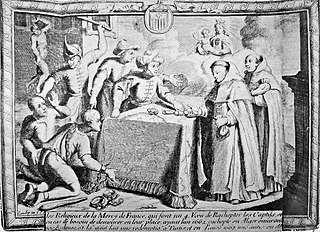Deaths
1637
- August - Jacob Collaert
This timeline of the history of piracy in the 1630s is a chronological list of key events involving pirates between 1630 and 1639.

Piracy is an act of robbery or criminal violence by ship or boat-borne attackers upon another ship or a coastal area, typically with the goal of stealing cargo and other valuable goods. Those who conduct acts of piracy are called pirates, and vessels used for piracy are called pirate ships. The earliest documented instances of piracy were in the 14th century BC, when the Sea Peoples, a group of ocean raiders, attacked the ships of the Aegean and Mediterranean civilisations. Narrow channels which funnel shipping into predictable routes have long created opportunities for piracy, as well as for privateering and commerce raiding.

Buccaneers were a kind of privateer or free sailors particular to the Caribbean Sea during the 17th and 18th centuries. First established on northern Hispaniola as early as 1625, their heyday was from the Restoration in 1660 until about 1688, during a time when governments in the Caribbean area were not strong enough to suppress them.

A privateer is a private person or vessel which engages in maritime warfare under a commission of war. Since robbery under arms was a common aspect of seaborne trade, until the early 19th century all merchant ships carried arms. A sovereign or delegated authority issued commissions, also referred to as letters of marque, during wartime. The commission empowered the holder to carry on all forms of hostility permissible at sea by the usages of war. This included attacking foreign vessels and taking them as prizes and taking crews prisoner for exchange. Captured ships were subject to condemnation and sale under prize law, with the proceeds divided by percentage between the privateer's sponsors, shipowners, captains and crew. A percentage share usually went to the issuer of the commission.

The Barbary pirates, Barbary corsairs, or Ottoman corsairs were mainly Muslim pirates and privateers who operated from the Barbary states. This area was known in Europe as the Barbary Coast, in reference to the Berbers. Slaves in Barbary could be of many ethnicities, and of many different religions, such as Christian, Jewish, or Muslim. Their predation extended throughout the Mediterranean, south along West Africa's Atlantic seaboard and into the North Atlantic as far north as Iceland, but they primarily operated in the western Mediterranean. In addition to seizing merchant ships, they engaged in razzias, raids on European coastal towns and villages, mainly in Italy, France, Spain, and Portugal, but also in the British Isles, the Netherlands, and Iceland.
Benjamin Hornigold (1680–1719) was an English pirate who operated during the tail end of the Golden Age of Piracy.
Murat Reis the Elder was an Ottoman privateer and admiral, who served in the Ottoman Navy. He is regarded as one of the most important Barbary corsairs.
John Ward, also known as Birdy or later as Yusuf Reis, was an English pirate who later became a Corsair for the Ottoman Empire operating out of Tunis during the early 17th century.

The Golden Age of Piracy is a common designation for the period between the 1650s and the 1730s, when maritime piracy was a significant factor in the histories of the North Atlantic and Indian Oceans.

Hayreddin Barbarossa, also known as Hayreddin Pasha, Hızır Hayrettin Pasha, and simply Hızır Reis, was an Ottoman corsair and later admiral of the Ottoman Navy. Barbarossa's naval victories secured Ottoman dominance over the Mediterranean during the mid-16th century.
Samuel Axe was an English privateer in Dutch service during the early 17th century.

Jacob Collaart or Collaert was a Flemish admiral who served as privateer and one of the Dunkirkers in Spanish Habsburg service during the Dutch Revolt.
Jan Janszoon van Haarlem, commonly known as Reis Mourad the Younger, was a Dutch pirate who later became a Barbary corsair in Ottoman Algeria and the Republic of Salé. After being captured by Algerian corsairs off Lanzarote in 1618, he converted to Islam and changed his name to Mourad. He became one of the most famous of the 17th-century Barbary corsairs. Together with other corsairs, he helped establish the independent Republic of Salé at the city of that name, serving as the first President and Commander. He also served as Governor of Oualidia.
Salah Rais was the 7th King of Algiers, an Ottoman privateer and admiral. He is alternatively referred to as Sala Reis, Salih Rais, Salek Rais and Cale Arraez in several European sources, particularly in Spain, France and Italy.
This timeline of the history of piracy in the 1620s is a chronological list of key events involving pirates between 1620 and 1629.
This timeline of the history of piracy in the 1640s is a chronological list of key events involving pirates between 1640 and 1649.

The Barbary slave trade, part of the Arab slave trade, involved the capture and selling of European slaves at slave markets in the Barbary states. European slaves were captured by Barbary pirates in slave raids on ships and by raids on coastal towns from Italy to the Netherlands, Ireland and the southwest of Britain, as far north as Iceland and into the Eastern Mediterranean.

The Salé Rovers, also known as the Sallee Rovers, were a group of Barbary pirates active during the 17th and 18th centuries in the Mediterranean Sea and Atlantic Ocean. Like other Barbary pirates, they attacked Christian merchant shipping and ransomed or enslaved any crew members and passengers they captured. Numerous Salé Rovers operated out of the Republic of Salé, which was established on the mouth of the Bou Regreg river and existed from 1627 to 1668. Many of the corsairs of the Salé Rovers were of European descent, most whom were English and Dutch Protestants. One such corsair was the Dutchman Jan Janszoon, who converted to Islam after being captured by Barbary pirates in 1618 and was renamed Murat Reis. By the 18th century, anti-piracy operations by European navies such as the British Royal Navy led to the eventual decline and disappearance of the Salé Rovers.
Jewish pirates were seafaring Jewish people who engaged in piracy. While there is some mention of the phenomenon in antiquity, especially during the Hasmonean period, most Jewish pirates were Sephardim who operated in the years following the Alhambra Decree ordering the expulsion of Iberia's Jews. Upon fleeing Spain and Portugal, some of these Jews became pirates and turned to attacking the Catholic Empire's shipping as both Barbary corsairs from their refuge in the Ottoman dominions, as well as privateers bearing letters of marque from Spanish rivals such as the United Netherlands.

Dragut was an Ottoman corsair, naval commander, governor, and noble. Under his command, the Ottoman Empire's maritime power was extended across North Africa. Recognized for his military genius, and as being among "the most dangerous" of corsairs, Dragut has been referred to as "the greatest pirate warrior of all time", "undoubtedly the most able of all the Turkish leaders", and "the uncrowned king of the Mediterranean". He was nicknamed "the Drawn Sword of Islam". He was described by a French admiral as "a living chart of the Mediterranean, skillful enough on land to be compared to the finest generals of the time" and that "no one was more worthy than he to bear the name of king". Hayreddin Barbarossa, who was his mentor, stated that Dragut was ahead of him "both in fishing and bravery".
This timeline of the history of piracy in the 1600s is a chronological list of key events involving pirates between 1600 and 1609.